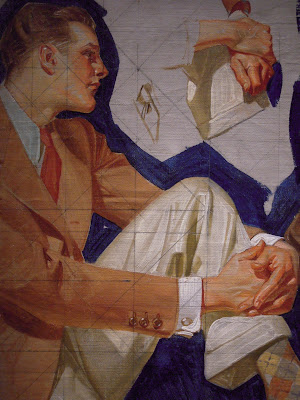 The New Britain Museum of American Art displays a drawing of a male fashion model by illustrator J. C. Leyendecker for Kuppenheimer's Men's Clothing Co., intended possibly for Country Gentleman Magazine, ca. 1920. The drawing illustrates the mastery of Leyendecker's craftsmanship, his regulating lines (hinted in the geometry of the socks), the care of the folded hands, the dreamy tilt of the head, the contrasting aquatic background, etc. Unlike other illustrators (like Norman Rockwell), Leyendecker has received little scholarly attention with only one book published since his death, Michael Schau, J. C. Leyendecker (New York, 1974). A new study by Laurence and Judy Cutler seeks to rectify this neglect, J. C. Leyendecker: American Imagist (New York, 2009), reviewed in Steven Heller, "Signs and Portents," New York Times Book Review (April 5, 2009), pp. 12-13.
The New Britain Museum of American Art displays a drawing of a male fashion model by illustrator J. C. Leyendecker for Kuppenheimer's Men's Clothing Co., intended possibly for Country Gentleman Magazine, ca. 1920. The drawing illustrates the mastery of Leyendecker's craftsmanship, his regulating lines (hinted in the geometry of the socks), the care of the folded hands, the dreamy tilt of the head, the contrasting aquatic background, etc. Unlike other illustrators (like Norman Rockwell), Leyendecker has received little scholarly attention with only one book published since his death, Michael Schau, J. C. Leyendecker (New York, 1974). A new study by Laurence and Judy Cutler seeks to rectify this neglect, J. C. Leyendecker: American Imagist (New York, 2009), reviewed in Steven Heller, "Signs and Portents," New York Times Book Review (April 5, 2009), pp. 12-13.The German-born Joseph Christian Leyendecer (1874-1951) produced hundreds of illustrations appearing continuously from the 1900s to the 1940s in The Saturday Evening Post, The Century, McClure's, Vanity Fair and other popular magazines. One of my favorite series is New Year Babies running on the cover of The Saturday Evening Post between 1908 and 1943. Leyendecker is also best known for his Arrow shirt ads and the beautiful Ivy League athletes embraced by gay visual history. The Atwater Kent Museum in Philadelphia, the New Britain Museum of American Art, the Norman Rockwell Museum in Stockbridge, and the National Museum of American Illustration in Newport (founded by the authors) have made important contributions in ushering low-brow graphic works into the canon of American art. For example, see my earlier posting, Norman Rockwell and Conn College and Cousin Reginald Spells Peloponnesus. The medium's popularity in the American public is best seen at antique stores or even at the listings of eBay, where original magazines are highly desirable and inexpensive. I have begun a small collection of Collier's and Saturday Evening Post's from the 1930s. Seeing the illustrations next to contemporary prose, fiction, ads and related graphics is my favorite way of understanding the genre and the decade. The prose--of mostly forgotten writers--matches the visual language; the rhetorical and interdisciplinary coherence is great. After a bit of research, it also becomes evident that artists of some repute contributed images, this being the subject of Double Lives: American Painters as Illustrators, 1850-1950 at the New Britain Museum of American Art. As was the intention in the original publications, I appreciate possessing the art intended for my class, poor man's masterpieces.
Unlike Rockwell, who in 2001 was ushered into the halls of high art (by a Guggenheim exhibition), Leyendecker has not received his due acclaim. Part of the problem is Leyendecker's homosexuality. As Cutler & Cutler point out, Leyendecker stayed away from the public eye to protect his homosexual private life at a time when it would have caused him professional and social persecution. He also purged any reference to homosexuality from his archive, making it doubly difficult for the historian to reconstruct the artist's intentions. In the 1980s, the homoerotic subtext in his work was recognized by gay subculture and he was immediately embraced as an artistic forefather. However, the homosexual branding has kept Leyendecker in a private drawer as a transitional but not conclusive figure in gay America's coming of age.
Regardless of sexual orientation, Leyendecker is profusely erotic. According to the new study, he painted in a dark room illuminated by a single candle to capture a transgressive erotic quality. His visual language, more than any of his contemporaries, encapsulates the sexual tensions of the 1920s, flapper liberties tamed by censorship. Sometimes, I feel that Leyendecker is forgotten because he was so successful in his primary objective, "creating images easily reproduced, immediately recognized and broadly distributed for audiences by the millions to appreciate." We have internalized Leyendecker's Jazz Age to such a degree, that we claim it as our own. This familiarity has thrown the true author into obscurity. The same can be said about our internalized vision of homey America in the work of Rockwell. But we have scratched deeper under the Rockwell surface because we know it won't be sexually uncomfortable. A broader study of Leyendecker would trace the trickling down effect of Leyendecker's qualities in all aspects of visual culture. Even in archaeology, my expertise, I see traces of Leyendecker in the handling of scaled figures (typically placed in elevation drawings).
I write my ponderings on American culture, homosexuality and aesthetics, while learning of the death of Eve Sedgwick, the literary historian who helped create the discipline of queer studies, see Claire Potter, "All About Eve," Tenured Radical and New York Times obituary. I can't say that I have been influenced by Sedgwick's research directly, but in the hope of refining my critical vocabulary, I hasten to her classic Epistemology of the Closet (Berkeley, 1990).
No comments:
Post a Comment